How to use body fat to increase cattle fertility
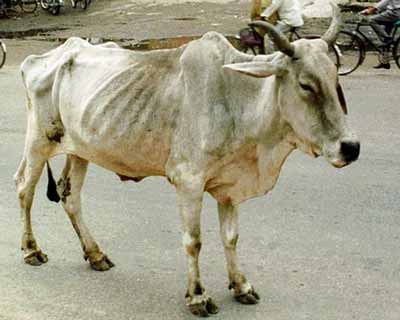
Image Credit: Miltos Gikas, Flickr, CC BY 2.0
If you have a cow-calf herd, you know how important cattle fertility is to your farm's survival. What if I told you that there is a powerful tool that allows you to dramatically improve conception rates in your herd while reducing production costs at the same time? And it's completely natural. It's your cows' body fat at calving time.
It probably doesn't come as a surprise that a half-starved cow is going to struggle to get pregnant. But what is a surprise is that body fat at calving time has a far greater influence on conception rates than body fat at breeding time. And it's also a surprise how much of a difference even small changes in body fat at calving time will have on conception rates.
So in this article I am going to explore this powerful correlation between body fat at calving time and fertility at breeding time. And I will share some management changes you can make on your farm to take advantage of this powerful correlation so you can increase conception rates in your herd while reducing your production costs at the same time!
Body fat during calving season trumps body fat during the breeding season.
Cattle fertility doesn't just bounce back immediately after calving. Cows are not instantly fertile again as soon as their calves hit the ground.
After calving there is an infertile period while the cow's body recovers from her pregnancy and starts preparing for her next breeding cycle. This infertile period, from the day of calving until the day the cows experience their first estrus cycle (or first heat), is called the postpartum interval.
And the length of this infertile period depends on how much body fat the cow has when she calves.
Many people mistakenly believe that fertility and conception rates at breeding time depend on how much body fat a cow has during the breeding season. While this certainly plays a small role, it is much less important than how much body fat a cow has at calving time!
The chart below shows how body fat affects the length of this infertile period after calving (1). As you can see, the difference is pretty significant!
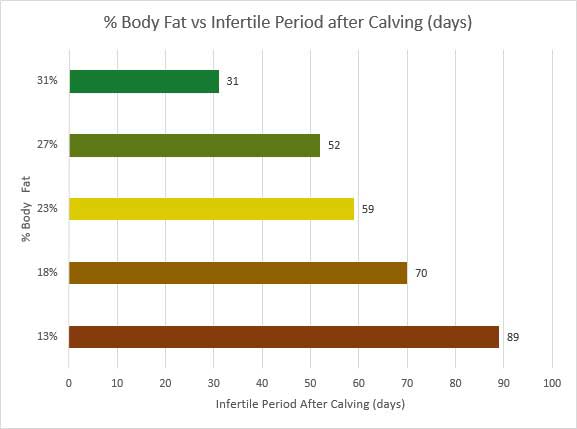 The length of the infertile period after calving depends on how much body fat a cow has at calving time.
The length of the infertile period after calving depends on how much body fat a cow has at calving time.For those readers accustomed to working with body condition scores, 13% body fat corresponds to a Body Condition Score of 3 (very thin) on the 9-point scale, 18% is a BCS of 4 (thin), 23% is a BCS of 5 (moderate), 27% is a BCS of 6 (good), and 31% is a BCS of 7 (very good) (2,3).
So let's put these numbers into context because they have huge implications for the conception rates in your cow-calf herd and for your overall beef production costs.
The length of the infertile period after calving affects conception rates
In the chart below I've superimposed these infertile periods on a cow-calf production calendar with a 42-day calving season. You'll notice that I've done it twice - once for the cows that calve early and again for the cows that calve late in the calving season.
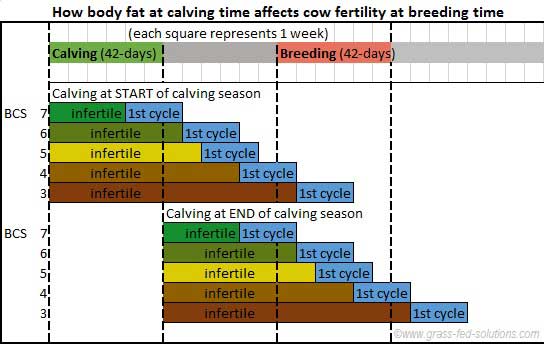 Cattle production calendar showing the infertile period and 1st estrus cycle of cows that calve at the beginning versus the end of the calving period.
Cattle production calendar showing the infertile period and 1st estrus cycle of cows that calve at the beginning versus the end of the calving period.Before I dissect this chart I'd like to mention why I've tacked on the 1st estrus cycle (in blue) at the end of the infertile periods shown on the chart.
A cow can conceive during the first estrus cycle after calving. But her fertility is still less than ideal during this 1st estrus cycle so her chance of a successful pregnancy is significantly lower. The first cycle is like a mock run to get the cow's system up and running again. Conception rates are much higher in the next cycle.
So if you want to maximize conception rates in your cattle herd, breeding should not start until after the entire infertile period AND the first estrus cycle.
Now back to the previous chart of the calving/breeding schedule. A quick glance at the second group of cow (the late calvers) shows where the problem lies in having skinny cows at calving time. They just don't have enough time to recover prior to start of the breeding season.
In fact, even the fattest cows that have the shortest infertile period after calving still have less than ideal fertility during a portion of the breeding season if they calve late in the season. Late-calving cows that are only modestly thin at calving have virtually no chance of rebreeding and the thinnest cows have no chance of conceiving at all. They won't even cycle yet while they are with the bulls!
And this scenario is using the recommended 42-day breeding season, which allows each cow two full estrus cycles to get pregnant while they are with the bulls. With a longer 60-day or 90-day calving season (not recommended), the late calving cows would be in even more trouble!
Body fat vs conception rates
This next chart turns all this information into an even more striking picture. It shows the pregnancy rate of cattle 90 days after calving depending on how fat they are at calving time (4).
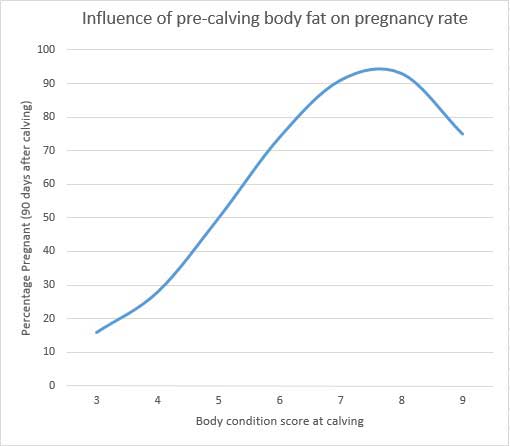 The effect of body fat at calving time on the probability of being pregnant 90 days after calving
The effect of body fat at calving time on the probability of being pregnant 90 days after calvingThat's quite a range of conception rates, from 15% for cows with a body condition score of 3 to well over 90% for cows with a body condition score of 7!
The obvious lesson from all this is that if you want your cows to rebreed easily, make sure they are nice and fat when calving season starts. Not too fat (fertility goes back down once cattle get obese), but fat enough to maximize fertility and conception rates.
But that is not the end of the story.
Gaining weight at calving time is important
There's another twist. In order for cows to achieve the pregnancy rates shown in the previous graph they also need to be gaining weight just before they calve!
Even if cows have ideal body fat levels at calving time, if they are using up some of that body fat to make up for a calorie deficiency in the days before they calve then they will not conceive as easily. The simple reason: losing weight before calving extends the time that cows remain infertile after calving just as if they had less body fat to begin with (5).
From an evolutionary standpoint it makes sense. Body fat is a fantastic trigger to ensure that the cow has enough energy reserves to take care of herself, her new calf, and also get pregnant again.
If body fat at calving time is low then poor fertility compromises the future pregnancy so that the cow has a better chance of taking care of her calf and herself without adding the energy drain of another pregnancy. And even if body fat levels are high, if her body fat reserves are being used (she's not gaining weight) at calving time, then that's a sign that food resources are dwindling, so again it is advantageous to reduce fertility to protect herself and her current calf.
Why body fat at breeding time is less important.
You may be tempted to think that if your cows are a little lean or losing a bit of weight at calving time you can rescue their fertility by ensuring that they are nice and fat when breeding season begins.
Wrong. Unfortunately this won't save the day. Here's why:
First of all, the countdown on the infertile period after calving starts when the calf hits the ground. You can't retroactively reset the clock.
It is true that body fat at breeding time makes a difference. If the cows have lost more body fat, this will further reduce their fertility, thus effectively slowing the clock still further. But what if the cows gain weight and increase their body fat reserves by the time breeding starts - will that speed up the clock and shorten the infertile period?
The problem with trying to speed up the clock is that cattle bodies prioritize how they expend their energy. First they take care of their own maintenance needs. Then they take care of producing enough milk for their current calf. And only if all those needs are met will any extra calories be available for weight gain.
While a cow is pregnant she can still gain weight fairly easily. The pregnancy takes some extra energy, but not so much that she cannot put on some body fat too. But once a cow calves her energy balance changes completely. Producing milk takes a huge amount of energy! Eating enough calories to gain body fat while lactating is nearly impossible.
The chart below shows how the energy requirements for maintenance, milk production and pregnancy compare:
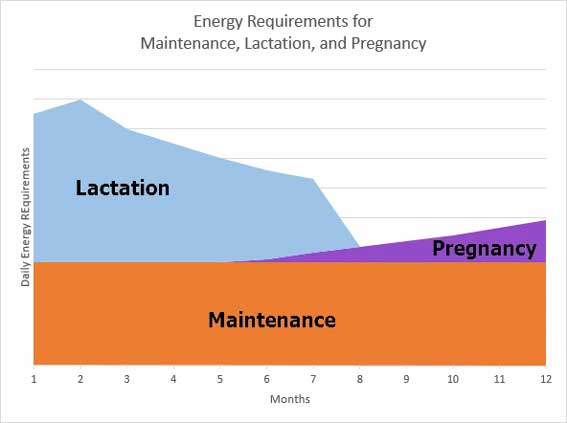 Cow energy requirements (maintenance, lactation, and pregnancy) over a 12-month period. If you also want the cow to gain weight you'll need to feed even more calories!
Cow energy requirements (maintenance, lactation, and pregnancy) over a 12-month period. If you also want the cow to gain weight you'll need to feed even more calories!As you can see, the calories (energy) required to produce milk are enormous - far beyond those required during pregnancy. And the extra calories required for weight gains have to be added to those required for maintenance plus lactation or pregnancy.
Feeding cows enough food so they can produce enough milk for their calves plus also gain weight at the same time requires such a high-calorie diet that it is nearly impossible to do. In reality, cows are likely to barely maintain or even lose a little bit of body fat once lactation starts, even on a prime lush pasture or on high quality feed.
Unless your cows poop pure gold, feeding them enough calories to produce milk plus gain weight themselves is utterly and completely unprofitable.
The challenge of maximizing conception rates and minimizing feed costs in a traditional spring calving season
Most cattle farmers use a spring calving season. What this actually means is that they calve before the growing season begins.
This puts them into a difficult balancing act. On the one hand they want to maximize their cows' body fat at calving time so their herd can re-breed successfully. On the other hand, making sure the cows are fat after a long winter takes a lot of cattle feed and that gets expensive.
So they have to strike a balance. They aim to have their cows in good condition at calving season, but only aim for a body condition score of 6 on the 9-point scale - an equivalent of 27% body fat. They don't give up too much fertility versus having them at a body condition score of 7 - enough cows still manage to rebreed to keep herd numbers stable - but they also don't have to feed so much expensive winter feed to make their business unprofitable.
It works - kind of - but it's not a recipe for low-cost cow-calf production. Keeping their cows at a body condition score of 6 means they cannot allow their cows to lose any weight over the winter. Which means that they cannot afford to continue grazing cheap winter pastures whose quality is slowly deteriorating because of the wind, rain, and snow. They simply cannot afford to let cows drop to a body condition score of 5 before they calve. Cheap winter pastures are out. They have no choice but to stick with expensive high-calorie winter feed.
But there is an another strategy that reduces winter feed costs, allows cattle to fatten up cheaply before they calve, provides all the calories required for lactation, increases fertility and conception rates, and won't cost you a dime in extra cattle feed!
Calving during the growing season - the secret to low-cost cow-calf production
Let's shift the timing of the calving season just a little bit to see what happens.
Imagine the cattle herd starts calving 4 to 6 weeks AFTER the growing season begins. These cows face a completely different situation than cows which calve before the growing season begins.
These cows have at least 6 weeks to fatten up on prime, lush, cheap pasture before they calve. Because they aren't lactating yet, even if they come out of the winter with a body condition score of 5, they have ample time and sufficiently low energy needs to be able to fatten up to a body condition score of 7 before they calve!
Increased fertility without the feed costs
A body condition score of 7 at calving time means their infertile period after calving will be much shorter. Conception rates will therefore be much higher than in a traditional spring calving herd. And you won't have spent a fortune on winter feed to achieve those high conception rates!
Tighter calving seasons
There is such a boost to cattle fertility when you switch to calving during the growing season that a much greater number of cows will calve during the first half of the calving season because they catch on the first breeding cycle! This makes for a much more uniform calf crop.
Lower replacement heifer costs
Higher conception rates also mean that you will need less replacement heifers to maintain your herd size. You can afford to cull all cows that had calving difficulties or whose calves got sick anytime between calving and weaning. That means only the very best genetics will make it into your brood herd and you'll have more excess heifers that can be sold, which increases your farm's bottom line.
Pasture-supported milk production
Milk production certainly isn't compromised by this calving schedule either. Calving 4 to 6 weeks into the growing season means that the cows still have most of the summer ahead of them to produce ample milk for their calves.
Healthier calves, more colostrum, and more milk
The benefits of summer calving also extends to the calves. Calves born on pasture tend to have less disease issues - small wonder when the weather is warm and dry and they are surrounded by a sea of fresh grass instead of mud and soiled bedding piles.
There is also a big boost to calf performance. More body fat at calving time causes cows to produce more colostrum for their calves (6). It's not just your imagination that pasture-born calves are more vigorous!
And that boost in performance doesn't end when the colostrum runs out. Cows with more body fat at calving time produce more milk for their calves over the next 4 months (7). So the calves will grow faster just because the cows have higher body fat when they calve!
Longer winter grazing seasons on cheap winter pastures
Calving during the growing season reduces your winter feed costs in several ways.
Because the cows have time to fatten up on spring pastures before they calve, they can be coasted through the winter on fewer calories than if you are trying to keep cows in prime condition all winter. They can even use a bit of their body fat to supplement themselves. So while your cows are on winter feed they'll need less of it to get by.
But if you master the skill of winter grazing you'll also have a shorter feeding season to contend with. Because the cows can gradually lose a bit of body fat during the winter (down to a body condition score of 5) they can spend a good portion of the winter grazing on cheap frozen pastures. They don't need to switch to expensive winter feed as early as cows that calve before the growing season begins.
How long you can continue grazing depends on your ability to create high quality winter pastures and on your winter grazing skills. The longer you keep grazing, the lower your feed costs. Some farmers hone their skills to such a degree that they can successfully graze frozen winter pastures right through the whole winter, even through deep snow.
Compensatory Gain
If you've read my article about compensatory gain, you know how efficiently cattle can gain weight after a period of weight loss. It's all thanks to how their metabolisms slow down to compensate for calorie-shortages and the delayed metabolic response after the period of weight loss ends.
Cows that end the winter at a body condition score of 5 will experience this compensatory gain when they are let out onto spring pastures, allowing them to gain weight extremely efficiently. This is part of the secret why they are able to bounce back up to a body condition score of 7 before calving after only 4 to 6 weeks of grazing on a high-calorie spring pasture.
Delayed weaning
If you're calving during the growing season, there is also no rush to wean in the fall. Other producers wean before they switch to their winter feed program so they can keep their cows from losing weight without spending a fortune on feed.
But if you calve during the growing season, letting the cows keep producing milk during the winter won't hurt your bottom line since it's okay if they lose a little weight. In fact, as I explain in my book, Grass Fed Cattle: how to produce and market natural beef, there are a lot of benefits to delaying weaning for as long as possible so the calves can gain a little extra weight from their mother's milk. As winter pasture quality declines, many cows will wean their calves on their own.
And a powerful alternate calf marketing strategy
Delayed weaning also suggests an alternative marketing scenario that allows you to produce as much beef as possible on cheap summer pastures.
By weaning as late as possible the cows effectively coast the calves through the winter very cheaply by supplementing them with a little extra milk. The longer you delay weaning, the longer the calves get that extra little bit of milk. As long as you monitor your cows body condition to ensure that their body fat reserves remain within safe levels (don't let them drop below a body condition score of 5 on the 9-point scale), you can let the calves stay with the cows all winter.
You can wean as late as 4 to 6 weeks before the next calving season, just as pastures start to green up, though many producers that graze right through the winter will wean a little earlier in order to prevent cow body condition scores from dropping below a BCS of 5.
In early spring you then take advantage of compensatory gain to fatten those calves on your own pastures and then either sell them as long yearlings in late summer or grass finish them yourself in the fall if you prefer. Either way, your cost of production is much much lower because the majority of those gains were produced on pasture and not in a winter feed pen. And by keeping calves longer, you need less cows to produce the same amount of beef each year. Less cows means even lower winter feed costs and more pasture available for fattening more calves.
And all because of a little tweaking in your timing so you can match your cattle's energy needs to the grass in your pastures!
Thumbnail Image Credit: Miltos Gikas, Flickr, CC BY 2.0
...
If you've found this article useful, please share it with three other farmers that you know - I appreciate your help in growing my audience! And if you have questions or comments, please share them below or connect with me on social media.
If you'd like to be notified when I release future cattle farming articles, sign up for my email notifications or follow me on Facebook or Twitter.
References:
- Houghton, P.L., R.P. Lemenager, L.A.Horstman, K.S. Hendrix and G.E. Moss. 1990. Effects of body composition, pre- and postpartum energy level and early weaning on reproductive performance of beef cows ans preweaning calf gain. J. Anim. Sci. 68:1438-1446.
- Fox, D.G., C.J. Sniffen and J.D. O'Connor. 1988. Adjusting Nutrient Requirements of Beef Cattle For Animal and Environmental Variations. J. Anim. Sci. 66:1475-1495.
- Wagner, j.j., K.S. Lusby, J.W. Oltjen, J. Rakestraw, R.P. Wettemann and L.E. Walters. 1988. Carcass composition in mature Hereford cows: Estimation and effect on daily metabolizable energy requirement during winter. J. Anim. Sci. 66: 603.
- SELK, G.E., R.P. Wettemann, K.S. Lusby, J.W. Oltjen, S.L. Mobley, R.J. Rasby and J.C. Garmendia. 1988. Relationships among weight change, body condition and reproductive performance of range beef cows. J. Anim. Sci. 66: 3153.
- Lahman, D.L., D.H. Keisler, J.E. Williams, E.J. Scholljegerdes and D.M. Mallet. 1997. Influence of postpartum weight and body condition change on duration of anestrus by undernourished suckled beef heifers. J. Anim. Sci. 75: 2003-2008.
- Odde, K.G. 1997. Reproductive efficiency, precalving nutrition, and improving calf survival. Proc. Bovine Connection, 860-092.
- Domecq, J.J., A.L. Skidmore, J.W. Lloyd, and J.B. Kaneene. 1997. Relationship Between Body Condition Scores and Milk Yield in a Large Dairy Herd of High Yielding Holstein Cows. J. Dairy Science. 80: 101-112



